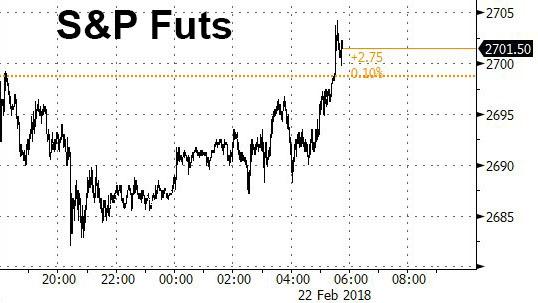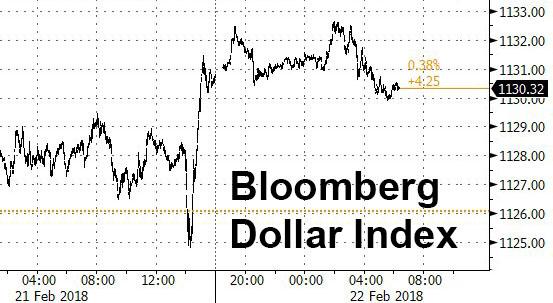Global stocks took another leg down during the early part of Thursday’s session, sliding to one-week lows in the wake of Wednesday’s unexpectedly market-moving FOMC minutes which confirmed the Fed was on track to raise interest rates several times this year, sending bond yields to new multi-year highs amid prospects for 4 rate hikes on deck (and according to Goldman, even 5 possible).
However, after sliding initially, S&P futures have since staged a rebound, rising as much as 20 points from session lows, and are currently back in the green, modestly above 2,700.

The rebound was helped by the end of the USD rally, as the dollar’s boost following the Fed minutes proved short-lived as the U.S. currency struggled to gain for a fifth day. Meanwhile, the euro was unfazed by a miss in German IFO data, finding support from broad dollar selling after the London open in a rather slow session. The dollar weakness sent EURUSD back to 1.23, while GBP underperforms after a disappointing GDP revision and the ongoing Brexit saga

In other key FX pairs, per BBG:
Three rate rises are now almost fully priced in for 2018, compared with two as recently as December, and some analysts are even contemplating the possibility of as many as five rate hikes in 2018.
And while 10Y TSY yields have traded rangebound within 2 bps of 2.93%, German bunds have unwound the sell-off seen post-FOMC Minutes, following disappointing German IFO data after Wednesday’s weaker-than-forecast European PMIs.The “transatlantic spread” between German and U.S. 10-year borrowing costs widened to near a year high at 220 bps, reflecting the diverging monetary policy expectations between the two countries.
The 3% level on 10Y TSY yields is seen as a huge psychological milestone for bulls and bears alike. In the meantime though the yield, which hit four-year highs around 2.96 percent after the minutes, retreated to 2.93%. Two-year yields touched new nine-year peaks.
A break in the U.S. 10- year treasury above the psychological level of 3% may prove sufficiently attractive to spur demand among foreign investors. This would support the dollar against CEEMEA currencies, Rabobank EMFX strategist Piotr Matys writes in a note to clients.
The next hurdle for markets will be minutes from the European Central Bank’s last meeting at 1230 GMT, with investors keen to see if there was more talk of an eventual unwinding of stimulus. One school of thought says that shifting perceptions about the ECB’s policy outlook had a significant role to play in the surge in U.S. Treasury yields that began in September and picked up speed last month, roiling global stocks.
European equities followed Asia peers lower: the Stoxx Europe 600 Index slid as all the major national equity gauges in the region fell. In terms of sector specific moves, material names modestly lag their peers following price action in the complex as well as a disappointing earnings update from Anglo American (-4%) which has sent their shares near the bottom of the FSTE 100; with the index also hampered by lacklustre earnings from the likes of British American Tobacco (-4.6%), Barratt Developments (-4.0%) and BAE systems. However, losses for UK stocks have been capped by a well-received earnings report from Barclays (+5.1%) which allied with upside in AXA shares (+1.2%) post-earnings has also supported the financial sector.
Earlier in Asia most shares retreated, though China’s market bucked the trend as it reopened after a holiday. The Nikkei (-1.1%) and Hang Seng (-1.5%) saw losses of over 1%, while ASX 200 (+0.1%) saw initial 0.4% gains trimmed, with price action in Australia largely dictated by the slew of earnings.
“The market is pricing in the possibility of a tighter Fed over time,” Evan Brown, director at UBS Asset Management, who previously worked on the open market trading desk at the New York Fed, told Bloomberg TV in New York. On a day-to-day basis “you’re going to see volatility, you’re going to see equities get a little skittish when yields are rising, but as you look over the long term, fundamentals on the economy are very strong.”
However, for now Bloomberg notes that markets remain fragile as February is shaping up as one of the worst months for global equities in more than a year as concerns about a pick-up in inflation and expensive stock prices outweigh evidence of a buoyant U.S. economy. With recent data underpinning the view that inflation is no longer lagging, the OIS space shows traders pricing in just shy of three U.S. rate hikes over the next 12 months.
Elsewhere, gold retreated alongside most commodities. WTI and Brent crude trade lower albeit off worst levels after falling victim to the firmer USD despite last night’s unexpected build in the API report. As a reminder, due to the President’s Day Holiday on Monday the weekly DoE report will be released today. In metals markets, gold prices have also been hampered by the firmer USD, however, the move to the downside has perhaps been contained due to the price action seen in EU stocks this morning. Elsewhere, steel prices were seen lower during Asia-Pac trade as Chinese participants slowly returned from holiday, with a bulk of the market not expected to fully return until next week.











Leave A Comment